
STRETCHING 13.6 KILOMETRES, PARTLY UNDERGROUND before it appears as a channelized waterway in Kelowna’s North End, this section of Brandt’s Creek often goes unnoticed.
But for Faculty of Creative and Critical Studies (FCCS) doctoral student Madeline Donald, there’s still a sense of vitality in the living things that survive there, albeit under difficult circumstances.
“The floodplain and habitats that extend from the land into these creeks are critical to life in the Okanagan Valley. Where there’s water, there’s life, but over 70 per cent of this creek has been channelized and ditched to accommodate industrial, commercial and urban expansion.
“It got me thinking about how waterscapes shape our landscape, and how urban infrastructures resist that as best they can.”
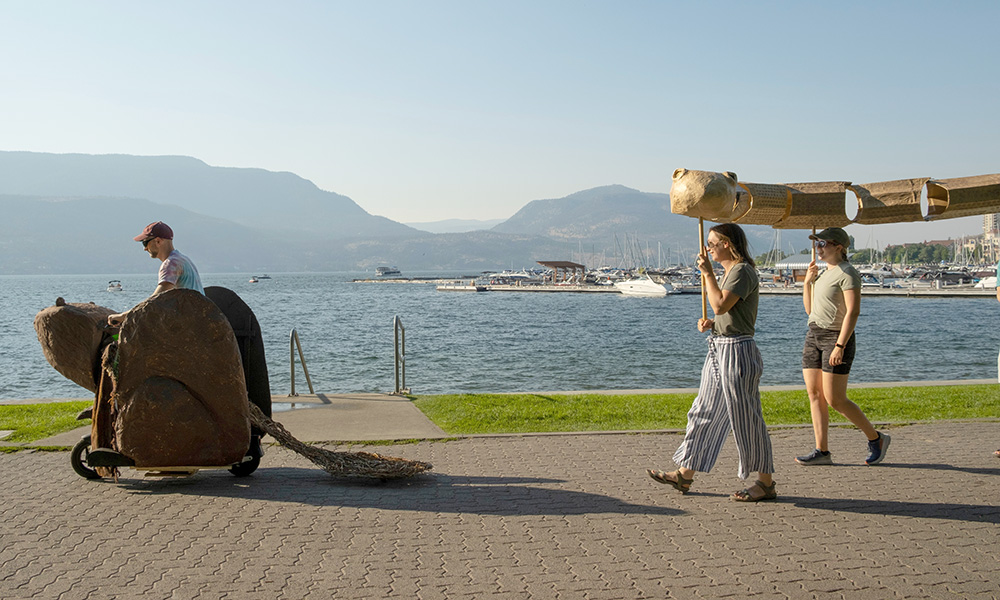
Andrew, Sarah, and Annie help Beaver and Rubber Boa meander down the impermeable shoreline in downtown Kelowna.

Kaylyn, Ray, Saturday and Moos illustrate shadow puppetry through Rubber Boa.
Sparking discussion through ecological puppetry
As part of a multi-pronged doctoral thesis in UBC Okanagan’s Interdisciplinary Graduate Studies program, Donald and several colleagues decided to run a research-creation experiment using puppets to explore the unique ecology of Brandt’s Creek.
“I wanted to test the transformative power of community art to generate much-needed conversations about life in the Okanagan and riparian habitats—meaning that interface between land and water in our rivers, streams, creeks and ditches.”
Titled “Riparian ReAnimation,” over the course of 22 weeks, Donald and her interdisciplinary, puppet-curious team—from dabblers to experts—held weekly community workshops to create and animate puppets made of a variety of household materials.
It was no small feat for Donald, who had ideas flowing through her mind and self-proclaimed “zero experience in the fine arts,” after previously graduating with degrees focused on the environmental sciences and ethnobotany.
That’s where she relied on the enthusiasm, experience and expertise of her partners, who helped workshop members brainstorm, develop and create the puppets.
“In the end I participated very little in the actual making of the puppets; that was for the attendees. They could come with whatever skills they possessed and contribute as little or as much as they wanted to,” explains Donald.
“Since the puppets were part of a larger project to revitalize interest in riparian places, participants were contributing to something bigger than what was happening in the puppet workshops. It was something even bigger than themselves.
“As we made these puppets, we talked in real time about what it’s like living in a floodplain and about the research I was doing alongside Brandt’s Creek.
“Ultimately, we were able to help facilitate this wonderful dialogue about ecology while also creating an accessible space for participants to be artistic and creative.”
In partnership with the Rotary Centre for the Arts, the Rhizome Eco-Social Education Society, Syilx Knowledge Holders Pamela Barnes and Jasmine Peone, as well as Cathy Stubington of Runaway Moon Theatre, the group created 10 biodiverse giant puppets, and many insects.
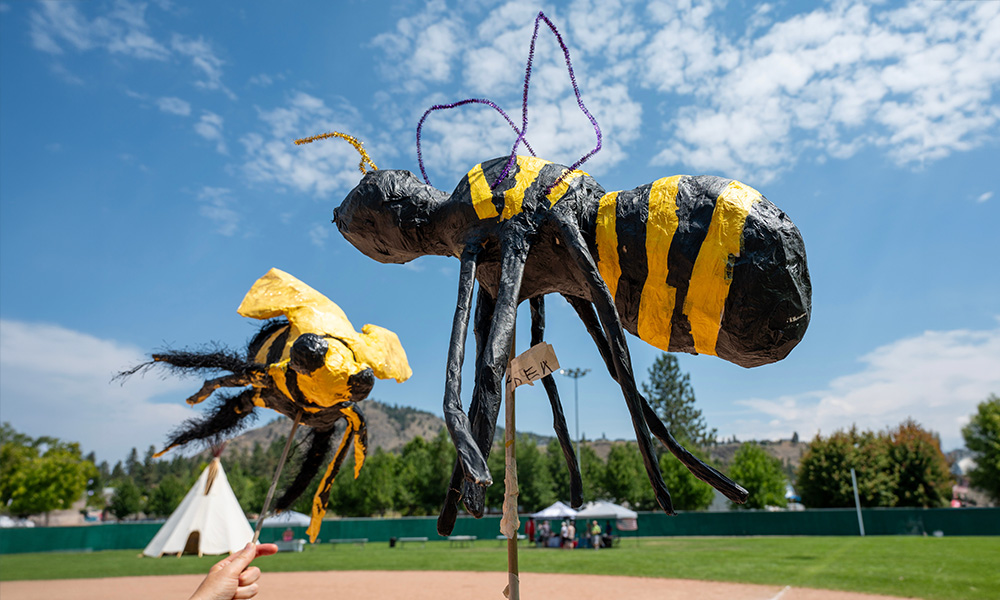
Bees make for good puppet projects with younger folks. One of these bees was made in the public workshops, the other, by a child-adult team from the Ki-Low-Na Friendship Society.
A turtle, ladybug, bees, Saskatoon berry, cottonwood, and others were then presented at various community art festivals and events throughout Kelowna—Donald’s way of further inviting community members to expand and explore their relationships with flowing bodies of water.
“We wanted to use these riparian character puppets to flood the now overwhelmingly concrete-covered terrain where they once used to flourish.”
Donald’s doctoral co-supervisor, Dr. Greg Garrard, says that the puppet installation helped bring the essence of her research to life, inspiring questions and provoking thought within the community.
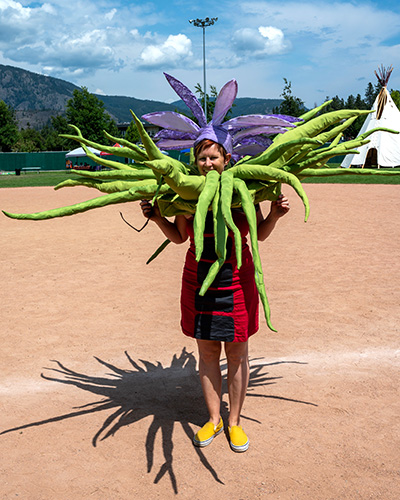
Shauna creates more shadows, this time of bitterroot—a culturally significant plant for the Syilx Okanagan People.
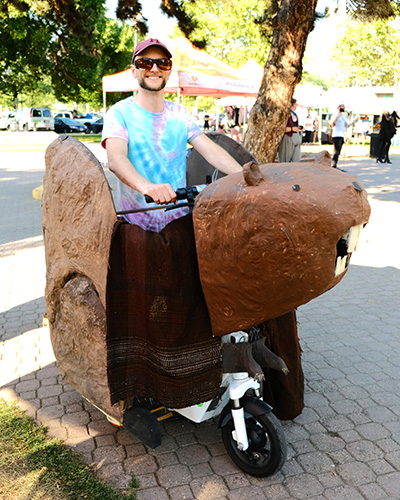
Andrew, the project’s champion at the Rotary Center for the Arts, rides Beaver, who is mounted on a scooter on long term loan from Lime.
“Maker-scholars like Madeline create objects that are strange, and that encourage us to see things we may otherwise not notice, like the ladybugs sitting on leaves or the bees that visit those riparian habitats to pollinate,” he says.
“How important are these creatures and habitats that we often ignore? Would a revitalized creek cause us to think differently about urban waterways?”
UBC Okanagan supports multi-disciplinary approaches to study
Despite pursuing a non-traditional methodology for part of her doctorate in Interdisciplinary Graduate Studies, Donald says she was supported and encouraged to go beyond her comfort zone and explore the issues at play with Brandt’s Creek.
“This project was a first for me in so many ways; I had never been in charge of a community art project, especially one this large, and I certainly don’t consider myself an artist,” Donald laughs.
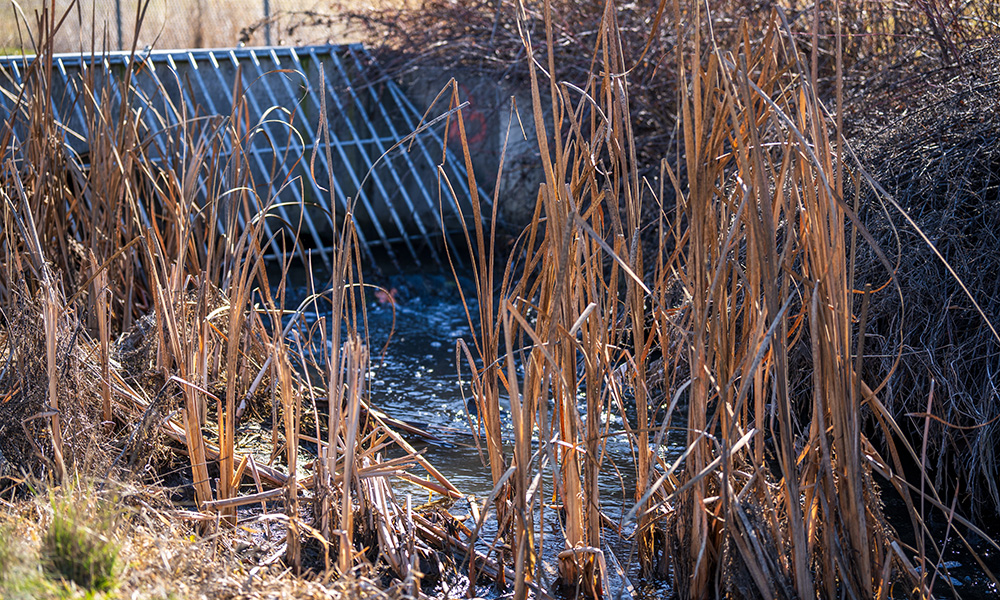
The valley-bottom portion of Brandt’s Creek is a plucky ditch, doing its best to a create riparian place under circumstances of containment and culverts.
“I had an idea, and I kept talking about it over and over again until, through conversation and persistence, it moved out of my head and into the community. I never would’ve thought, as someone new to Kelowna, that I’d be able to create a space here and bring people together to discuss issues with the landscape.
“But I did it in partnership with all these wonderful people from varied walks of life, and the fact that it succeeded represents the FCCS culture. My supervisors, Dr. Garrard and Dr. Natalie Forssman, thought my idea was unconventional, but they encouraged me to pursue my research.”
According to Dr. Garrard, Donald’s project was a great mobilizer of knowledge from the university to the community, bringing the two worlds together.
“Madeline was able to synthesize for people what it means for species to live in this overlooked space of Brandt’s Creek, and what the potential could be for a revitalized waterway. Her work has laid the groundwork for what the team hopes will be a long-term project to transform Brandt’s Creek into a cherished watercourse for the city.
“Ultimately there’s a different way of thinking about these urban waterways, and how we as a society can do better.”




